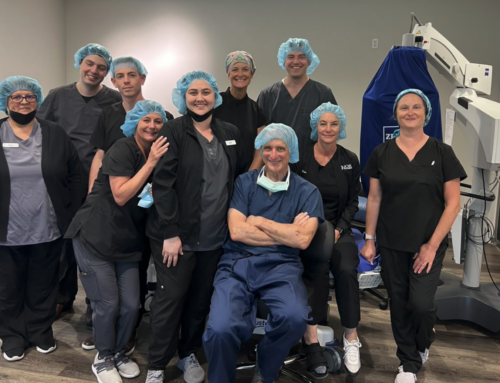Nearsightedness has risen dramatically over the last 50 years. If nothing is done to help slow the increase, half the world’s population may be nearsighted by the year 2050. That means much more than simply more people needing glasses. It means a lot of kids today are at risk of developing vision-threatening eye conditions over time. The Alliance for Eye and Vision Research believes this is such a serious issue with long range consequences, they organized a presentation to address Congress to talk about this issue earlier this month.
Why Nearsightedness is a Problem
People who have myopia, also known as nearsightedness, can see close-up objects clearly, but objects farther away are blurry. Myopia that begins in early childhood often worsens as the child grows. If these changes are too extreme, it can be hard to correct the blurriness with glasses or contact lenses and the risk of potentially blinding eye conditions rises, including retinal detachment, glaucoma, early cataracts and myopic maculopathy, a leading cause of blindness world-wide.
Myopia (nearsightedness) is a refractive error. Refractive error is when the eye does not bend (refract) light properly. Light does not focus correctly so images are not clear. In myopia, close objects look clear but distant objects appear blurred. Myopia is a common condition that affects an estimated 25% of Americans. It is an eye focusing disorder, not an eye disease.
The socioeconomic impact is also devastating. Studies estimate that the global impact of uncorrected myopia results in a $244 billion annual productivity loss, while blindness from myopic macular degeneration results in a $6 billion annual productivity loss.
Nearsightedness: Myopia Symptoms
Some of the signs and symptoms of myopia include:
- eyestrain,
- headaches,
- squinting to see properly, and
- difficulty seeing objects far away, such as road signs or a blackboard at school.
These symptoms may become more obvious when children are between ages 8 and 12 years old. While more research is required to understand why myopia is on the rise, new treatment options are available to slow the disease in children so the most devastating consequences of high myopia can be avoided.
Myopia occurs when the eye is longer than normal or has a cornea that is too steep. As a result, light rays focus in front of the retina instead of on it. In this case, you see near objects clearly, but distant objects will appear blurred. Some studies have found that increased near work and lack of outdoor exposure in childhood may enhance the expression of myopia in some people.
Eyeglasses and contact lenses
Eyeglasses or contact lenses are the most common methods of correcting myopia symptoms. They work by refocusing light rays on the retina, compensating for the shape of your eye. Eyeglasses can also help protect your eyes from harmful ultraviolet (UV) light rays. A special lens coating that screens out UV light is available.
Refractive surgery
In many cases, people may choose to correct myopia with LASIK or another form of refractive surgery. These surgical procedures improve your vision by reshaping the cornea. The reshaped cornea focuses light properly onto the retina.
About this article:
Read this article on AAO: https://www.aao.org/newsroom/news-releases/detail/nearsightedness-is-public-health-crisis
The American Academy of Ophthalmology is the world’s largest association of eye physicians and surgeons. A global community of 32,000 medical doctors, we protect sight and empower lives by setting the standards for ophthalmic education and advocating for our patients and the public. Our EyeSmart® program provides the public with the most trusted information about eye health. For more information, visit aao.org.
 At Barth Vision & Optical we have the latest styles of sunglasses for summertime fun and protection. Visit us at our new Healdsburg location (640 Healdsburg Ave.) to discover your next great pair of sunglasses. We also offer State-of-the-art eye examinations, A unique collection of fashion eye wear, Cataract surgery & consultation, LASIK vision correction, Eye Care Telemedicine. Call Today for an Appointment (707) 955-1120.
At Barth Vision & Optical we have the latest styles of sunglasses for summertime fun and protection. Visit us at our new Healdsburg location (640 Healdsburg Ave.) to discover your next great pair of sunglasses. We also offer State-of-the-art eye examinations, A unique collection of fashion eye wear, Cataract surgery & consultation, LASIK vision correction, Eye Care Telemedicine. Call Today for an Appointment (707) 955-1120.


